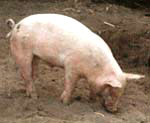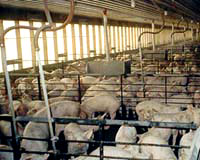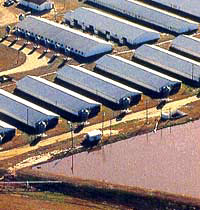“Campaign reform” is much too polite a phrase. “Ending corruption” is more like it. I could — and maybe I will — write a column a week from now till next fall’s election counting the ways campaign contributions corrupt our government, destroy our public assets, and rob taxpayers.
Today’s example is industrial hog farming.

This little piggy went to market.
As recently as 20 years ago, most pigs were raised on family farms. Farmers kept a few pigs as “mortgage lifters,” turning grain into a higher value product. In 1980 the U.S. had 700,000 pig producers, most with fewer than 100 sows.
Now there are just 150,000 producers, 90,000 of them still small, providing just four percent of the nation’s pork, barely hanging on. Forty percent of our pig meat now comes from 1,000 huge producers — Murphy’s Family Farms, Tyson’s, Smithfield, Seaboard, Premium Standard — several of which are currently merging with each other.
These industrial producers of “The Other White Meat” have learned from mega-chicken-factories how to raise tens of thousands of animals in acre-size, climate-controlled, automated, antibiotic-soaked buildings. Actually the companies rarely raise the hogs themselves. They provide indentured farmers with buildings, piglets, medicines, chemicals, sometimes feed, and buy back hogs at fixed prices. The farmers do the work, bear the risk, live with the smell, and deal with the obvious disposal problem.
We are told that this industrial way of raising swine is cheaper. At the farm level it is, because it takes less labor. There’s no noticeable price difference at the consumer end, however. What happened over the past 20 years is that the packer’s share of each pork dollar rose from 16 to 22 cents and the retailer’s share from 47 to 60 cents, while the farmer’s share fell from 37 to 18 cents. That’s what’s putting small farms under.

These little piggies stayed in their (crowded) home.
Photo courtesy Environmental Interest Organization.
In Missouri the average $5 million hog factory generates 50 new jobs and displaces 150 independent farmers. Family farmers spend about 80 percent of their revenues within 20 miles of their farms, but mega-farms spend less than half their take locally. In the two North Carolina counties with the most industrial hog operations, unemployment has risen and sales and property taxes have fallen.
What does any of this have to do with corruption? Well, for a start, these hog factories slide in on political grease. While Wendell Murphy of Murphy Family Farms served 10 years in North Carolina’s General Assembly, regulatory control of large pig farms was taken from counties and relegated to the state. The state then exempted the farms from liability for environmental or health damage. Then it decided they needn’t pay gas, sales, or property tax either.
As the number of hogs in North Carolina rose from 2 million to 13 million, surpassing the human population, the number of hog farms dropped from 21,000 to 7,000. The state now boasts 480 big hog facilities and 3,800 open-pit manure lagoons, each roughly the size of a football field and about 12 feet deep. (Who decided to call those things lagoons?)
The manure is supposed to be sprayed onto agricultural fields. But a single hog operation in southwest Utah, designed to turn out 2.5 million hogs annually, will produce as much raw sewage as the city of Los Angeles. There aren’t nearly enough fields within trucking distance.
States that welcomed hog factories without asking hard questions are now embroiled in messes. Indiana has suffered more than 200 hog manure spills and is getting around to leveling fines for them. Premium Standard Farms in Missouri has been found guilty of fraudulent construction practices, multiple manure spills, and worker abuse. One Illinois county saw property values go down by 30 percent because of the smell of large hog operations.
The lead state, when it comes to hog problems, is North Carolina. Swine operations there produce more sewage than all the state’s towns and cities put together. There are over 600 abandoned manure lagoons. By Murphy’s law their owners are liable for nothing.

Return to the brown lagoon.
Photo courtesy Environmental Interest Organization.
In 1995 a lagoon break spilled into a North Carolina river, killed 10 million fish, and closed 364,000 coastal acres to shellfishing. Then came Hurricane Fran, which washed more lagoons into waterways, but did not lead to new regulations. The Raleigh News & Observer asked in 1996: “Did no one learn anything from Hurricane Fran? Is the Division of Water Quality so foolish as to think the winds won’t blow, the rains won’t fall, and the rivers won’t rise again?”
By last fall, when Hurricane Floyd blew in right after Hurricane Dennis, there were 3,000 large hog operations on North Carolina’s coastal plain. The flood carried hundreds of thousands of gallons of hog manure, combined with oil from underground tanks and chemicals from industry, into streets, wells, and living rooms. Thirty thousand dead hogs were plowed into shallow pits in the floodplain. The North Carolina Pork Council then had the gall to apply for $1 billion in federal aid to repair flooded hog facilities.
Eighty percent of North Carolina’s legislators have received campaign contributions from the hog industry. In 1996 Farmers for Fairness, the pork industry’s cover organization, spent $3.2 million to defeat hog-unfriendly candidates — more than any other political action committee or political party in the state. The largest recipient of pork donations was Gov. Jim Hunt (D), who once advocated reform of the industry, but now just wants to study the problem. Bob Hall, research director for the nonprofit organization Democracy South, says, “Hog money spread throughout the legislature is another way this industry is polluting our state’s quality of life and our democratic freedoms. The influence and access this money buys — to the Governor’s office, to both parties, to legislative leaders — poisons the environment for discussing meaningful regulation of the hog industry.”
In any functional democracy, massive animal-feeding operations, if permitted at all, would be tightly regulated, fined for their infractions, taxed like everyone else, and made to clean up their messes at their own expense. That will never happen until we get the hog money — and while we’re at it the chicken money and the beef money — out of politics.

